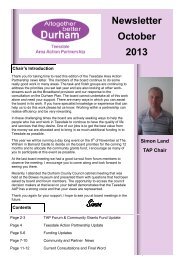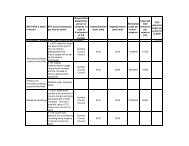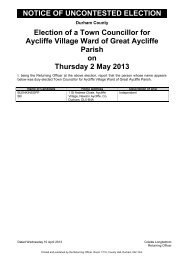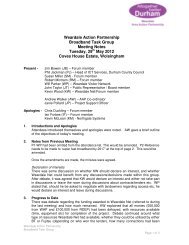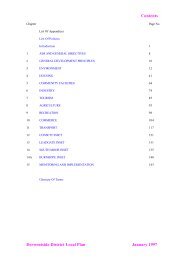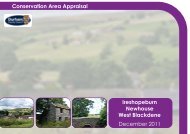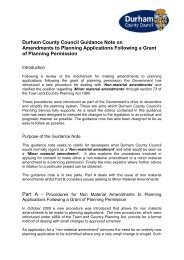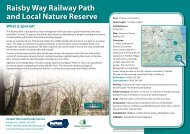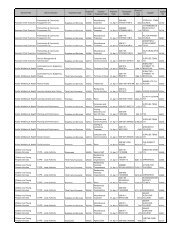SECTION 3.0 - Durham County Council
SECTION 3.0 - Durham County Council
SECTION 3.0 - Durham County Council
Create successful ePaper yourself
Turn your PDF publications into a flip-book with our unique Google optimized e-Paper software.
Public authorities have a Duty to have regard to the conservation of biodiversity<br />
in<br />
exercising their functions. This Duty was introduced by the Natural Environment<br />
and Rural Communities<br />
Act<br />
and came into force on 1 October 2006. The Duty aims to raise the profile and<br />
visibility<br />
of biodiversity, clarify existing commitments with regard to biodiversity, and<br />
to make it a natural and integral part of policy and decision making. The Duty<br />
applies<br />
to all public authorities including local authorities, central government<br />
departments, executive agencies, non departmental public bodies, regional<br />
government offices, non-ministerial departments, NHS Trusts, regional assemblies,<br />
utilities and all other bodies carrying out functions of a public character under a<br />
statutory power. Public authorities can make a significant contribution towards the<br />
2010 target<br />
to halt biodiversity loss.<br />
• Planning Policy Guidance 17: Planning for Open space, Sport and<br />
Recreation (PPG17)<br />
Link with<br />
This guidance has been a key driver to encourage local authorities to Open Space,<br />
write green space strategies. It states that local authorities should Recreation,<br />
‘undertake robust assessments of the existing and future<br />
needs of their Leisure and<br />
communities for open space, sports and recreational facilities’. The Play Technical<br />
Paper (No.5)<br />
companion guide to PPG17 suggests<br />
ways in which such<br />
assessments<br />
can be made and defines a need to establish the extent<br />
to which open spaces meet clearly identified local needs and the wider<br />
benefits they generate for people, wildlife, biodiversity and the wider environment.<br />
• Planning Policy Statement 1: Delivering Sustainable Development ( PPS1)<br />
This document sets out the governments national<br />
policies on different aspects of<br />
land use planning in England. It sets out the overarching planning policies on the<br />
delivery<br />
of sustainable development through the planning system.<br />
PPS1 states that: ‘Planning should facilitate and promote sustainable and inclusive<br />
patterns<br />
of urban and rural development by:<br />
- protecting and enhancing the natural and historic environment,<br />
the quality<br />
and character of the countryside….A high level of protection should be<br />
given to most valued townscapes and landscapes, wildlife<br />
habitats and<br />
natural resources. Those with national and international designations should<br />
receive the highest level of protection.’<br />
There are a number of similarities with PPS9 as paragraph 19 states that:<br />
Planning policies and planning decisions should be based on:<br />
- up-to-date information on the environmental characteristics of the area;<br />
- the potential impacts, positive and negative, on the environment of the<br />
development proposals (whether direct, indirect, cumulative, long-term or<br />
short-term); and<br />
- recognition of the limits of the environment to accept further development<br />
without irreversible damage.<br />
Page 19 4/15/2009




